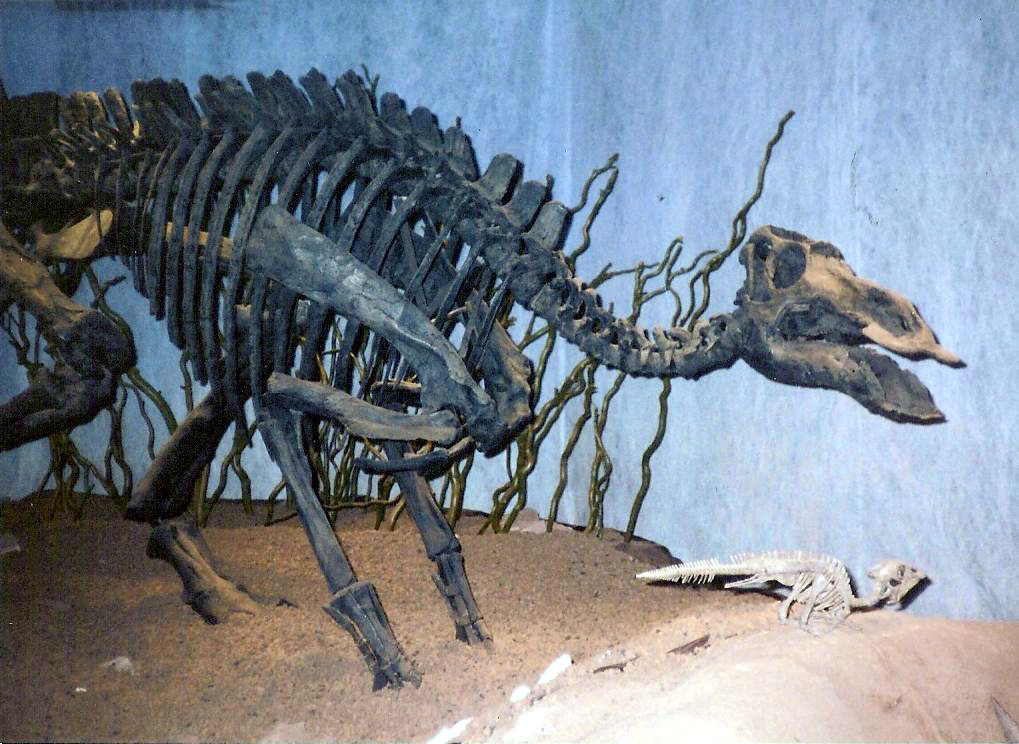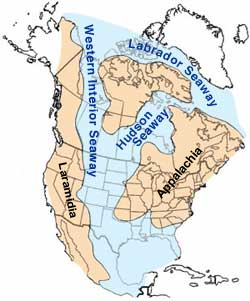
Creationists who think Noah’s Flood was a real historical event have a lot of explaining to do. Because nothing in the geologic record fits with their model of this universal deluge, they have to explain virtually every rock outcrop or fossil find by special pleading. Rocks today may form one way, they plead, but in Noah’s Flood conditions were different. Fossils today form by known processes, they argue, but the Flood created unique, special conditions.
The order of fossils in rock layers is a big problem for creationists. Simply put, if Noah’s Flood happened, we would expect all the animals of the world to be swept up together and deposited together. Fossil beds would have the jumbled bones of those wicked pre-Flood humans mixed with dinosaurs mixed with trilobites in one giant chaotic layer.
In reality what we see is quite different. Trilobite fossils are found in rocks without a trace of dinosaurs, and dinosaurs fossils are found in rocks without a trace of humans. And never—not even once—have trilobite fossils been found next to human bones, or next to dinosaur bones.
Acts & Facts is the journal of the Institute for Creation Research, the organization founded by Henry Morris, co-author of the 1961 classic creationist book The Genesis Flood. An article in the February 2015 Acts & Facts by Tim Clarey sought to explain the problem of why dinosaur fossils are where they are:
Evolutionary scientists view Earth’s rock layers as a chronological record of millions of years of successive sedimentary deposits. Creation scientists, on the other hand, see them as a record of the geological work accomplished during the great Flood’s year-long destruction of the Earth’s surface. If that is the case, though, why don’t we find dinosaur fossils in the earliest North American Flood sediment layers--why do we find them only in later Flood rocks?
 Why indeed. For geologists, the answer is straight-forward: dinosaurs thrived on the edges of a vast inland sea that used to span the North American continent from Texas to Canada. The margin of this Western Interior Seaway was fertile and rich in life. We find dinosaur fossils in Montana because at that time Montana was near the edge of this inland sea. Dinosaurs were there because that’s where the food was.
Why indeed. For geologists, the answer is straight-forward: dinosaurs thrived on the edges of a vast inland sea that used to span the North American continent from Texas to Canada. The margin of this Western Interior Seaway was fertile and rich in life. We find dinosaur fossils in Montana because at that time Montana was near the edge of this inland sea. Dinosaurs were there because that’s where the food was.
Creationists propose another explanation:
It seems the dinosaurs were able to survive through the early Flood in the West simply because they were able to congregate and scramble to the elevated remnants of land … I call this high ground Dinosaur Peninsula.
Uh huh, right. So instead of the central part of the US being a relatively low region—low enough to invite in the vast Western Interior Seaway—this area is now proposed to have been high ground, high enough to provide shelter in the flooding world. No evidence or citations for this extraordinary claim are offered.
The Acts & Facts article goes on:
As the waters rose, Dinosaur Peninsula began flooding from south to north … It’s as if the dinosaurs were fleeing northward up the peninsula as the waters advanced from the south.
This remarkably detailed scenario is supported with evidence of…well, it’s not really supported by evidence at all. Clarey does mention a discovery by Jack Horner of “over 10,000 adult Maiasaura in a small area, and yet no young were mixed in with them.” The article explains:
The adult dinosaurs were likely stampeding away from the imminent danger of raging floodwaters; their young could not keep up…
But that’s not quite right. For one thing, the ten thousand individuals thing is an estimate of herd size, rather than a comprehensive tally (and in fact recent research puts the number much higher).
When I wrote Jack Horner to ask about this article’s allegation of a lack of juveniles, he told me:
Baby maiasaurs, from hatching size of about 0.5 meters in length up to about 2 meters in length, are found in the nesting grounds where they were cared for by their parents.
So, there are young Maiasaura fossils there after all.
Far from exclusively displaying the fossils of stampeding adults, sites in Montana such as Egg Mountain are known for great quantities of Maiasaura eggs. Nests full of eggs, to my mind, suggest a lack of panicking and the presence of youngsters. (Science does not yet know if Maiasaura adolescents went through an awful surly stage as teenagers, rolling their eyes in contempt at their parents while whining, “But Bobby’s parents don’t make him have a curfew! So unfair!”)
So the strange, brief life of the alleged “Dinosaur Peninsula” ends with its drowning in an ocean of opposing facts. Because reality is so misaligned with what they “know” to be true, creationists must rely on special pleading in almost every instance. Are dinosaur fossils not where you expect them? Invent a previously unknown Dinosaur Peninsula to account for their position. Do the fossil rich layers of the world tell a different tale than your idea of how Noah’s Flood should have been? Say that some special process sorted out organisms at different levels.
It’s more than special pleading—it’s just plain wrong.
